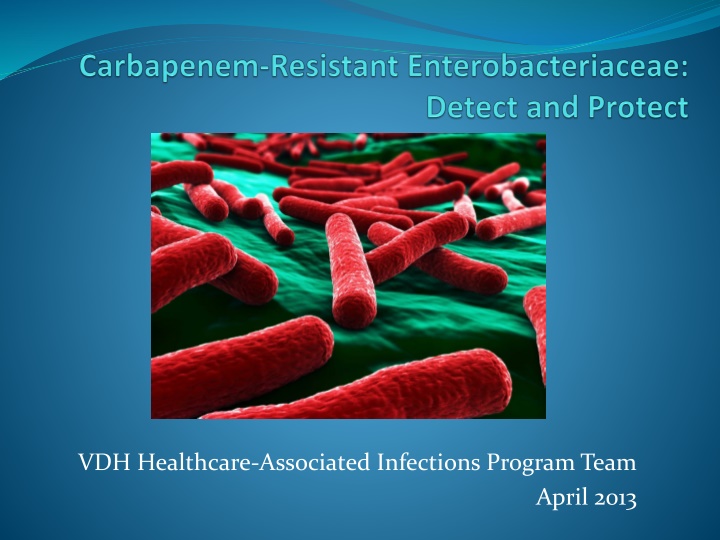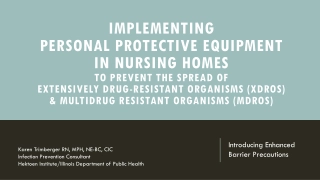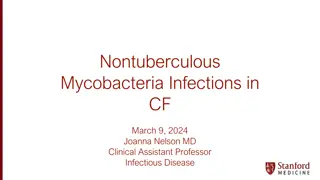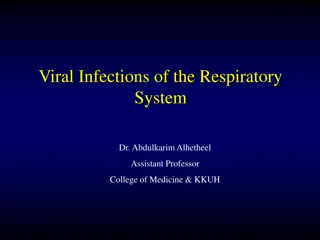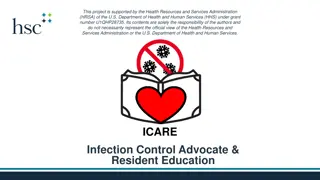Carbapenem-Resistant Enterobacteriaceae Infections
Carbapenem-resistant Enterobacteriaceae (CRE) present a significant challenge in healthcare settings due to their resistance mechanisms, risk factors, and rapid spread. This article delves into the background, resistance mechanisms, epidemiology, and unique characteristics of CRE infections, highlighting their impact on patient care.
Download Presentation

Please find below an Image/Link to download the presentation.
The content on the website is provided AS IS for your information and personal use only. It may not be sold, licensed, or shared on other websites without obtaining consent from the author.If you encounter any issues during the download, it is possible that the publisher has removed the file from their server.
You are allowed to download the files provided on this website for personal or commercial use, subject to the condition that they are used lawfully. All files are the property of their respective owners.
The content on the website is provided AS IS for your information and personal use only. It may not be sold, licensed, or shared on other websites without obtaining consent from the author.
E N D
Presentation Transcript
VDH Healthcare-Associated Infections Program Team April 2013
Background Carbapenem antibiotics (ertapenem, imipenem, meropenem, and doripenem) are often used as the last line of treatment for infections caused by resistant Gram-negative bacilli Over the past decade, members of the Enterobacteriaceae family of bacteria have begun to develop resistant to carbapenems and these resistant bacteria have spread throughout the U.S. Klebsiella spp., especially K. pneumoniae E. coli Enterobacter spp. CRE refers to carbapenem-resistant Enterobacteriaceae
Resistance Mechanisms and Risk Factors Carbapenemase enzymes confer resistance to carbapenems. Most prevalent carbapenemase in the U.S. is Klebsiella pneumoniae carbapenemase (KPC) Yet CDC suggests US distribution likely heterogeneous Persons at risk are those receiving serious medical care: Invasive medical devices Open wounds Long courses of antibiotic therapy Unusual resistance mechanisms (NDM-1, VIM, OXA-48) Risk factor: recent (within last 6 months) exposure to hospitalization in a country outside the US
Epidemiology Jan-June 2012: 4% of U.S. hospitals reported at least one patient 18% of long-term acute care hospitals reported at least one patient Last 10 years: One type of CRE infection reported in medical facilities in 42 states More common in Northeast CRE with unusual resistance mechanisms As of mid-Feb 2013, 37 reports in U.S. 15 since July 2012 Since then, at least 2 more cases in VA alone (both NDM-1) First two cases of OXA-48 identified in US were from Virginia (2012) http://www.cdc.gov/vitalsigns/hai/cre/ Mathers et al. First Clinical Cases of OXA-48-Producing Carbapenem-Resistant Klebsiella pneumoniae in the United States: the Menace Arrives in the New World. Journal of Clinical Microbiology 2013;51(2): 680-683.
CRE: Just Another Type of MDRO? What makes CRE special No decolonization strategy Few treatment options available High mortality rate (50% or greater in some studies) Resistance can hop between many Enterobacteriaceae (there are over 70 bacteria in the Enterobacteriaceae family) High speed/rate of resistance transfer
CRE in Long-Term Care Settings CRE not just in acute care hospitals Since 2004, reports of CRE cases from long-term acute care hospitals (LTACHs) and long-term care facilities CRE prevalence as high as 50%, even with few infections Potential for large reservoir of patients with CRE Multiple comorbidities Concentrated in one location for extended time period
CRE Concerns In addition to spreading among people, CRE easily spread their antibiotic resistance to other kinds of germs Making those potentially untreatable Infections could begin appearing in otherwise healthy people
Inter-Facility Transmission of MDROs (Including CRE) Munoz-Price SL. Clin Infect Dis 2009;49:438-43. Facilities with known CRE: complete inter-facility transfer form when transferring patients (include CRE status, presence of open wounds/devices, antimicrobial use and length of therapy)
Critical Opportunity for CRE Control: Detect and Protect
Current CDC Guidance for CRE Control Coordinated efforts from all stakeholders Acute and long-term care facilities Key principles: Recognizing epidemiologic importance of CRE Understand prevalence of CRE within a given region Identify colonized and infected patients in facilities Implement regional and facility-based interventions to halt transmission
2012 CDC CRE Toolkit Facility-level recommendations Acute care Long-term care Health department involvement Varies depending on regional prevalence Focused emphasis on preventing further transmission and widespread emergence of CRE http://www.cdc.gov/hai/organisms/cre /cre-toolkit/index.html
Know Your Baseline Quantify clinical evidence of these organisms Review archived lab results Number and/or proportion of Enterobacteriaceae that meet CRE definition May elect to focus on E. coli and Klebsiella spp. Specified time period (6-12 months) How soon after admission into facility are CRE identified? Evidence of inter-facility transmission? Intra-facility transmission? Which units/wards most affected? Consider collecting basic epidemiology of patients colonized or infected with CRE Patient demographics, dates of admission, outcomes, medications, common exposures
Interim CRE Surveillance Case Definition Nonsusceptible to one of the following carbapenems: doripenem, meropenem, or imipenem AND Resistant to all of the following third-generation cephalosporins that were tested: ceftriaxone, cefotaxime, and ceftazidime. (Note: All three of these antimicrobials are recommended as part of the primary or secondary susceptibility panels for Enterobacteriaceae) Klebsiella species and Escherichia coli that meet the CRE definition are a priority for detection and containment in all settings; however, other Enterobacteriaceae (e.g., Enterobacter species) might also be important in some regions. For bacteria that have intrinsic imipenem nonsusceptibility (i.e., Morganella morganii, Proteus spp., Providencia spp.), requiring nonsusceptibility to carbapenems other than imipenem as part of the definition might increase specificity.
Facility-Level Prevention Strategies Acute and Long-Term Care Core Measures Hand Hygiene Contact Precautions Healthcare Provider (HCP) Education Minimize Device Use Patient and Staff Cohorting Laboratory Notification Antimicrobial Stewardship CRE Screening
Hand Hygiene Educate staff Orientation and periodically Monitor hand hygiene adherence and provide feedback Ensure access to hand hygiene Install alcohol-based hand gel dispensers in patient rooms
Contact Precautions (CP) Acute Care Patients colonized or infected with CRE Consider pre-emptive CP for patients transferred from high-risk setting System to identify patients at admission CDC Health Advisory: History of recent inpatient stay in hospital outside US? Ensure proper PPE by HCP Hand hygiene before gown and gloves Gown and gloves before entering patient s room Remove gown and gloves, hand hygiene before exiting Monitor adherence and provide feedback Not enough information for firm recommendation re: discontinuation
Contact Precautions Long-Term Care Modify by risk Use Contact Precautions: Dependent on HCP for activities of daily living Ventilator-dependent Incontinent of stool Wounds with drainage that is difficult to control Consider relaxing Contact Precautions: Continent of stool, less dependent, w/o draining wounds ALWAYS observe Standard Precautions
HCP Education What is CRE? Basic education about MDRO prevention Hand hygiene Contact precautions Appropriate handling of invasive devices, removal of devices when no longer needed
Device Use Minimize use of invasive devices Ensure implementation of HICPAC recommendations Urinary catheters Central lines Ventilators
Patient and Staff Cohorting Place CRE patients in single-patient rooms If not available, cohort patients in the same room Preference for single rooms given to patients at highest transmission risk (stool incontinent, medical devices, open wounds) To the extent possible, cohort CRE patients to specific areas and staff Cohort patients with CRE infection or colonization to specific units/wards or a specific area within the unit/ward Dedicate staff to CRE patients or minimize the number of staff caring for CRE patients
Laboratory Notification Perform appropriate screening for CRE Use up-to-date lab standards Protocols in place for notification Notify clinical staff Notify infection prevention Applies to both on and off-site laboratories
Promote Antimicrobial Stewardship Ensure antimicrobials are used for appropriate indications and duration Use narrowest spectrum appropriate antimicrobial
CRE Screening Purpose: to identify unrecognized CRE colonization among high risk patients Point prevalence Rapid evaluation of CRE prevalence in particular unit(s)/affected area(s) One time if few or no additional CRE patients identified Conduct serially if colonization more widespread and/or to follow effect of intervention Epi-linked (e.g., roommate) Screening indicated for patients with history of recent inpatient stay in hospital outside US Stool, rectal, or peri-rectal cultures http://www.cdc.gov/HAI/pdfs/labSettings/Klebsiella_or_Ecoli.pdf For surveillance cultures, may also consider cultures of wounds or urine (if urinary catheter present)
Supplemental Measures for Facilities with Ongoing CRE Transmission Active surveillance cultures Culturing patients not epi-linked to known CRE patients but meet certain criteria (e.g., admitted from LTCF, admitted to ICU) Chlorhexidine bathing Diluted liquid (2%) or 2% chlorhexidine-impregnated wipes Daily in high risk (e.g., ICU) Less frequent in LTCF Applied to all patients in affected unit(s), not just those with CRE infection/colonization
In Your Facility Is the laboratory able to identify CRE? How is a CRE defined? Are there any barriers to implementing the recommended prevention strategies? Your Infection Control Committee may be able to help brainstorm solutions to address some of the challenges regarding surveillance and prevention of CRE
Inter-facility Communication In detect and protect , communication is key! When transferring patients with CRE infection/colonization from your facility, indicate: CRE status of patient Presence of open wounds/devices Antimicrobial use and length of therapy If CRE present on admission to facility (within 2 days), communicate information to originating facility
Role of Public Health in CRE Assess CRE incidence/prevalence Provide situational awareness to facilities Serve as resource to facilities re: prevention and control Assist with coordination of laboratory testing when indicated, especially in situations with outbreaks and when unusual type of CRE suspected or confirmed Phone a Friend!
Priorities for Testing/Screening For patients admitted to healthcare facility in the U.S. after recent hospitalization (within 6 months) in countries outside the U.S., consider: Rectal screening cultures to detect CRE colonization. Place patients on Contact Precautions while awaiting the results of these screening cultures. When a CRE is identified in a patient (infection or colonization), send the isolate to a reference laboratory for confirmatory susceptibility testing and test to determine the carbapenem resistance mechanism; at a minimum, this should include evaluation for Klebsiella pneumoniae carbapenemase (KPC) and NDM carbapenemase.
Please Report to Local Health Department Suspected or confirmed outbreaks of CRE CRE infection or colonization Any patient suspected or confirmed to be infected or colonized with one of the unusual forms of CRE (e.g., NDM or VIM carbapenemases). The local health district will work with you and DCLS to assist with appropriate laboratory evaluation for these new forms of CRE.
Regions with Few CRE Identified: Infection Prevention Facility w/o CRE but located in Region where CRE present: Engage facility administrators to prioritize CRE prevention Ensure CRE control plan is in place Reinforce core prevention measures Guide implementation of active surveillance testing and preemptive Contact Precautions for: Patients admitted from facilities with ongoing CRE transmission Patients admitted from LTACHs/LTCFs or with CRE risk factors (open wounds, indwelling devices, high antimicrobial use)
Regions with Few CRE Identified: Infection Prevention Facility with CRE present: Engage facility administrators to prioritize CRE prevention Review infection prevention practices to ensure core prevention measures are in place Provide in-service training (as needed) Ensure CRE screening in place and guide implementation of supplemental measures If CRE rates do not decrease, consult health department and/or regional experts for additional guidance
Regions with Few CRE Identified: Education of all Healthcare Facilities Explain importance of CRE and provide updates on regional prevalence and epidemiology Review recommended surveillance and prevention measures Increase vigilance for CRE detection Overview of CRE surveillance and prevention strategies for acute care and long-term care facilities (developed by VDH) 1-page Cliff Notes version of CDC CRE toolkit Plans for additional education for healthcare facilities and health department staff
Resources CDC CRE Toolkit (2012): http://www.cdc.gov/hai/organisms/cre/cre-toolkit/index.html CDC Health Advisory (Feb 2013): http://emergency.cdc.gov/HAN/han00341.asp CRE Vital Signs (Mar 2013): http://www.cdc.gov/vitalsigns/hai/cre/ CDC CRE website: http://www.cdc.gov/HAI/organisms/cre/index.html CDC CRE lab protocol: http://www.cdc.gov/HAI/pdfs/labSettings/Klebsiella_or_Ecoli .pdf VDH MDRO website: http://www.vdh.virginia.gov/epidemiology/surveillance/hai/ MRSAandMDRO.htm
Questions? VDH HAI Team: 804-864-8141 April Achter HAI/Influenza Epi Andrea Alvarez Program Coordinator Carol Jamerson Nurse Epi Angela West Central Region Epi Angela.West@vdh.virginia.gov 804-864-8232
